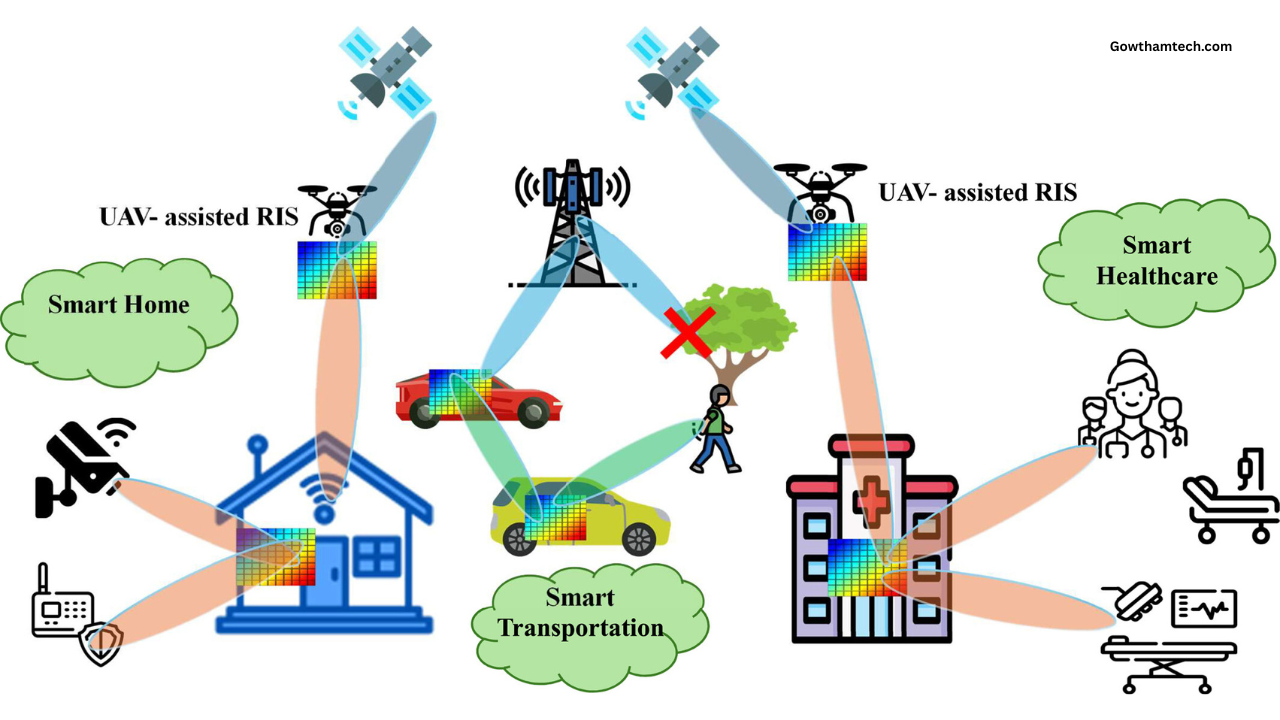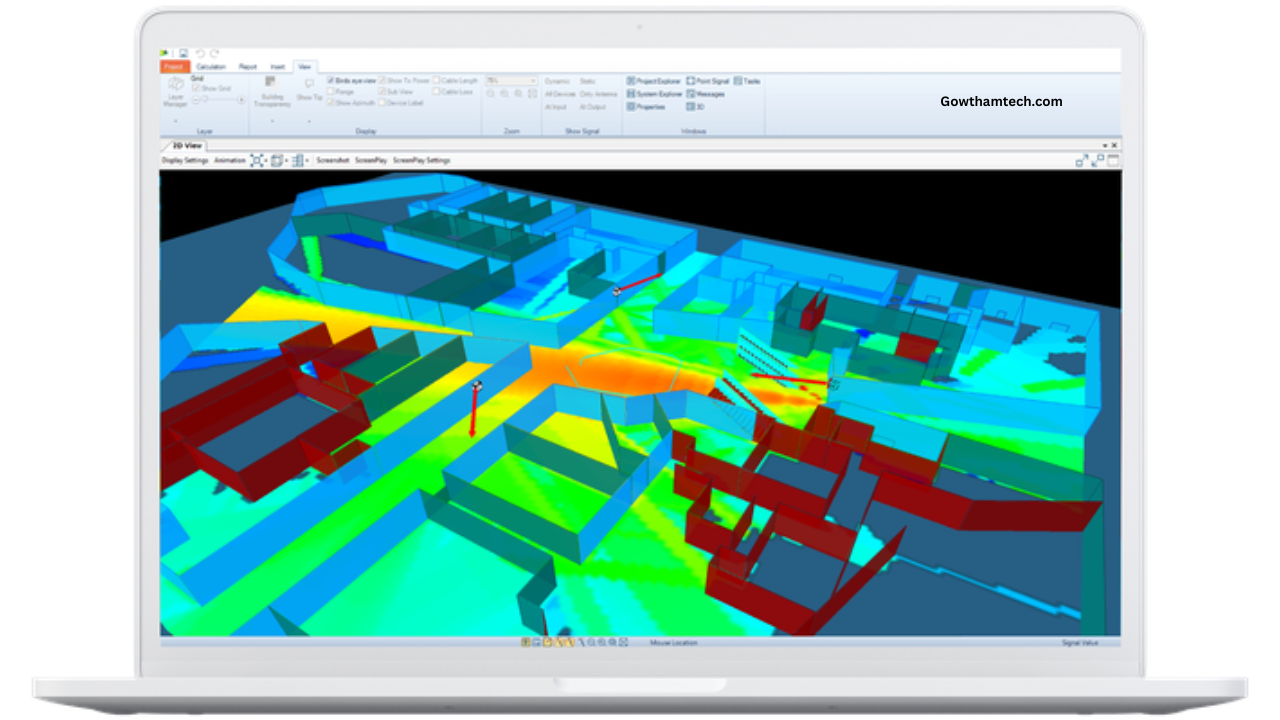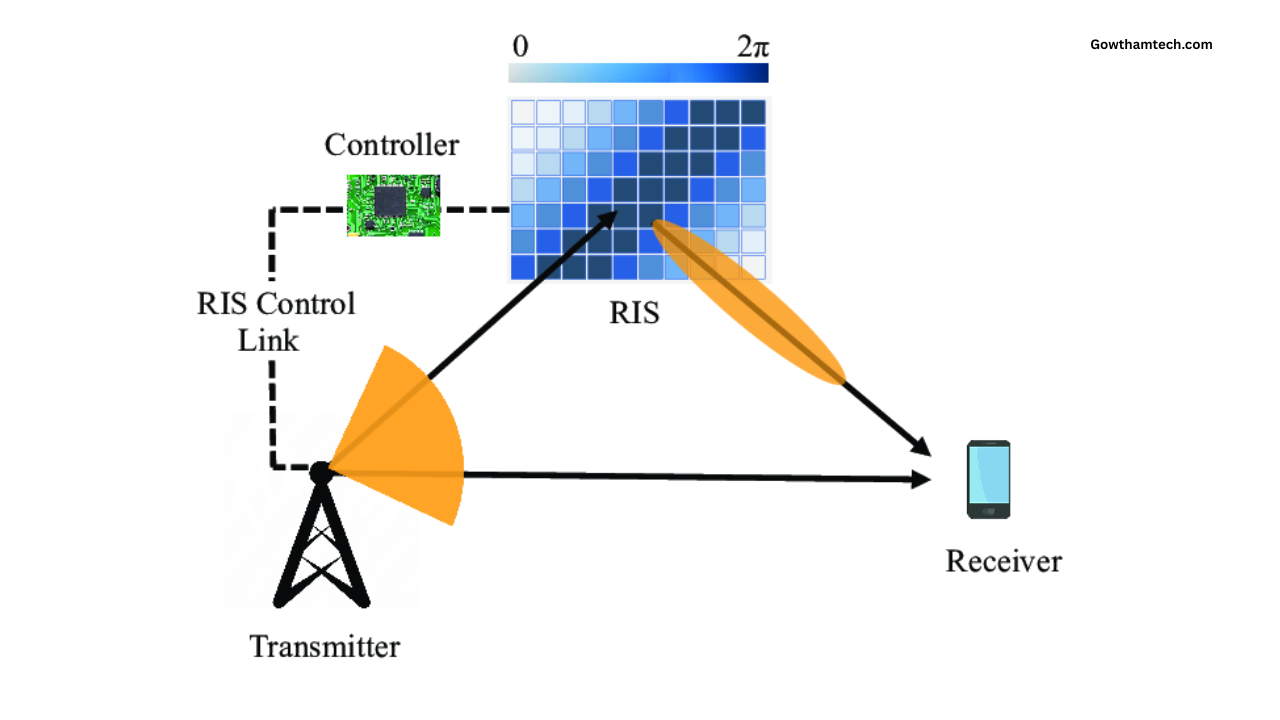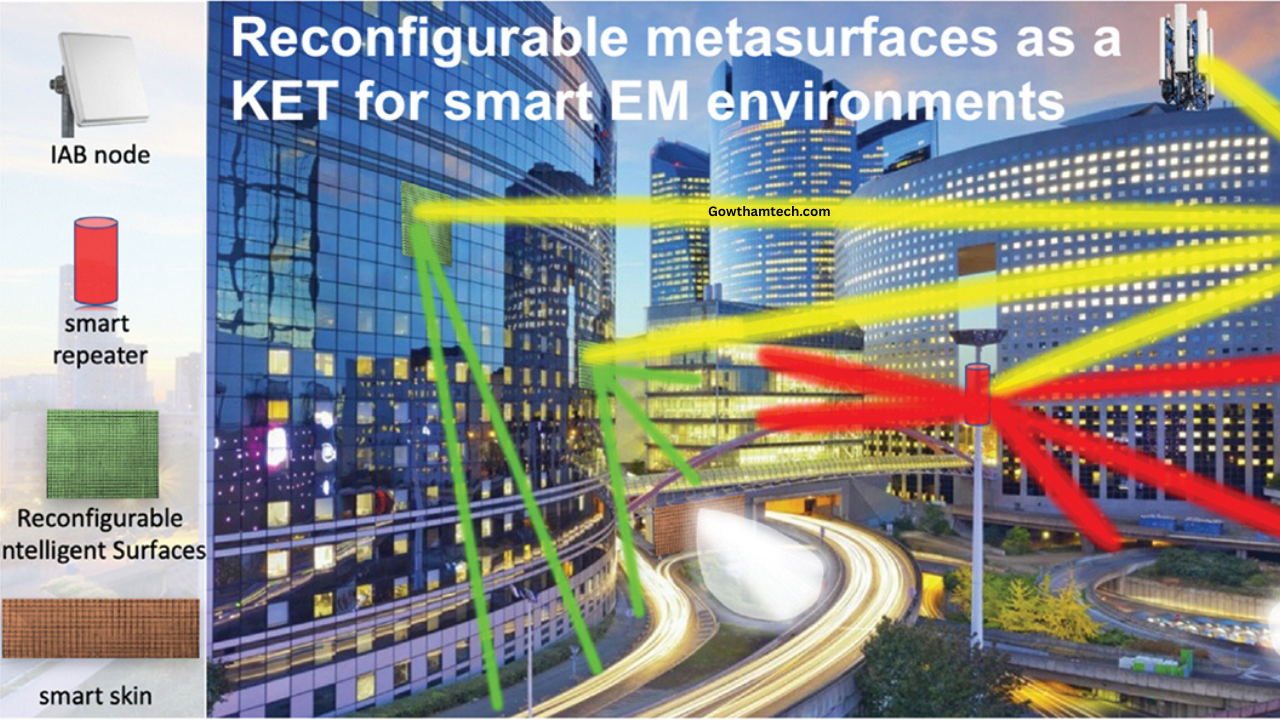The story of wireless communication has always been one of sheer force. The technology has evolved to create stronger transmitters more sensitive receivers and sophisticated antennas that send signals into an unpredictably and sometimes dangerous setting.
The wireless channel the area between the two receivers as an uncontrollable wild factor that needs to be compensated for but not to be controlled. What if we were able to control the wireless channel? How about transforming the walls windows and even the surfaces we walk on to active players in the conversation process?
It is the futuristic technology that lies in Reconfigurable Intelligent Surfaces. They are an innovative technology that is poised to become the foundation of 6G as well as the connected world of the future.
By 2025 Reconfigurable Intelligent Surfaces (RIS) often referred to as smart reflection surfaces (IRS) are quickly moving from the theoretical realm of scientific papers to concrete prototypes within advanced research labs as well as early stage testbeds.
This book is a comprehensive guide to this fascinating technological frontier. This guide will unravel the scientific basis of how smart surfaces function examine the possibilities of their transformation and look at the apps that are set to transform our daily lives on the internet.
In addition to boosting the signal of your mobile at a packed stadium and enabling highly reliable manufacturing automation Reconfigurable Intelligible Surfaces arent just an incremental improvement; they are an entirely new way of thinking about how we build and manage wireless networks.
Come along as we look at the design features as well as the future directions for technology that will be programming the physical world for unmatched wireless efficiency.
How Do Reconfigurable Intelligent Surfaces Work? The Science of Smart Reflections
In essence Reconfigurable Intelligent Surfaces are an artificial two dimensional layer made of electromagnetic material that has properties which can be controlled dynamically at any time. Consider it as not an ordinary mirror rather as it is a “digital” mirror for radio waves that is composed from thousands of microscopic parts that can be individually controlled. Instead of reflecting signals in a specific direction it has the ability to modify and create the radio waves that are impinging to reach the desired goal of communication.
For a better understanding lets look at the three main elements of an common RIS system:
- The Metamaterial Surface The metamaterial surface is a “metasurface” a sheet of material which have electromagnetic properties which arent found in the natural world. This is organized in a grid or an arrangement of smaller active elements.
- The array of meta atoms (Unit Cells) Every tiny component on the grid is an “meta atom” or “unit cell.” They arent antennas in the conventional sense theyre passive elements (like tiny patches of metallic material or dipoles) which do not need an energy source to power their transmission. The secret lies in their capability to change the direction of an incident radio signal. Every meta atom has the ability to be calibrated to give a certain change in the phase of the signals that it reflects. In other words one element may shift the wave 90 degrees while the next element shifts it 180 degrees.
- It is the Smart RIS Controller: This is the brain behind the system. It is a microcontroller equipped with advanced algorithms. It is connected to the base station of wireless networks in order to know the condition of the communications channel as well as the location of the receiver and transmitter. From this data it calculates the ideal phase shift for every meta atom that is on the surface. When applying the determined “phase gradient” across the whole array the control will collectively direct the radio wave with precision.
This process is as follows the radio signal coming from the base station (e.g. the 5G/6G tower) arrives at the reconfigurable Intelligent Surface. This RIS controller after receiving instructions sets the phase shifts for the meta atoms of.
When the light reflects from the surfaces its transformed. Instead of scattering in random ways and scattered the signal is concentrated into a narrow targeted beam which is aimed precisely toward the device intended for use.
It transforms a unreliable or blocked signal into a clear strong real time line of sight. The ability of Reconfigurable Intelligible Surfaces to manage the radio waves propagation is what makes them effective.
Reconfigurable Intelligent Surfaces in 2025: From Theory to Early Adoption
2025 will be an important moment of transition for Reconfigurable intelligent Surfaces. The technology is transitioning away from pure research in academia and moving into a new phase of rapid prototypes standardization as well as early stage exploration for commercial use.

Although you cant locate an RIS enabled wallpaper in your local electronics retailer in the near future the fundamental research being conducted now is making way for mass use in the second portion of the decade.
Standardization and Pre Commercial Testbeds
Large telecommunications standards organizations including the 3rd Generation Partnership Project (3GPP) that oversees standards for cellular communications and are currently investigating the significance of Reconfigurable Intelligent Surfaces
to be used in future versions that will lead to the 6G era. Research institutes as well as large telecom companies including Nokia Ericsson Samsung and Huawei have invested heavily in developing testbeds for real world use.
The testbeds are located on the industrial parks university campuses as well as urban areas provide valuable information about the way RIS operates outside of the ideal conditions in a laboratory. They help engineers solve important issues like channels state information (CSI) collection enhancing the control algorithms and understanding the effects of physical positioning on performance of the network.
Early Prototypes and Material Science Advances
The implementation of physical Reconfigurable Intelligent Surfaces is also moving forward fast. The first prototypes were usually heavy and energy intensive to manage. However by 2025 advances in metamaterials and micro electro mechanical systems (MEMS) are enabling the creation of thinner more efficient and potentially transparent surfaces.
Researchers are testing graphene and liquid based design concepts that promise quicker reaction times as well as lower energy consumption of the control circuitry. Development of low cost manufacturing processes is an important area of focus since the final goal is Reconfigurable Intelligent Surfaces that are inexpensive enough for widespread deployment.
Integration with AI and Machine Learning
The most significant development for 2025 is the extensive incorporation that will bring Artificial Intelligence (AI) and Machine Learning (ML) into RIS control system. Wireless environments are incredibly complicated and constantly changing. By using ML a RIS controller will be able to understand the pattern of propagation for radio signals in its surroundings in real time and anticipate the optimal setup to support users while they are moving.
This approach based on AI is vital for managing the complexity of a network that has hundreds of reconfigurable intelligent Surfaces and a multitude of users. This makes the idea of a completely self optimizing autonomous network actual possible.
Key Advantages and Transformative Potential of Reconfigurable Intelligent Surfaces
The excitement over Reconfigurable Intelligent Surfaces comes from an exclusive set of benefits that solve one of the fundamental issues with wireless communications.
1. Enhanced Signal Strength and Coverage Extension
This is the quickest and evident advantage. The reconfigurability of Intelligent Surfaces will help to overcome dead zones and signal interference. When a person is in an building or is around a corner of base stations a RIS placed in a nearby wall may “bend” the signal around the obstruction significantly increasing the strength of received signals and speeds of data. It is no longer necessary to set up expensive and energy hungry active repeaters or tiny cells for a variety of scenarios.
2. Unprecedented Energy Efficiency
Wireless networks especially base stations consume huge amounts of power. The components of the Reconfigurable Intelligent Surface are nearly inactive (only the controller is required to use only a tiny amount of energy) it is possible to boost the performance of networks with little energy usage.
In creating effective signal paths RIS allows base stations as well as user devices to communicate using less power and extend the life of batteries of mobile devices and decreasing the environmental footprint of networks. The “green” aspect is a important factor in the acceptance of the technology.
3. Heightened Wireless Security
Reconfigurable Intelligent Surfaces are a revolutionary level that provides physical security. Because they focus signal energy at the user who is intended to use it while reducing the signals power across all directions.
This makes it more difficult for eavesdroppers to be able to intercept communications. A RIS could be programmed to block any signal that is directed towards the malicious person and create a safe communications bubble.
4. Improved Spatial Multiplexing and Capacity
In cities with dense populations signal strength from the base station may reach users via multiple routes and cause interfering. A RIS is able to intelligently integrate multiple path signals to the receiver transforming the issue (interference) into a benefit (stronger signals).
In addition by generating separated thin beams reconfigurable intelligent Surfaces enable an base station to talk with a variety of users at that same band of frequency while causing minimum interference. It dramatically boosts the capacity for the mobile.
5. Low Cost and Easy Deployment
In comparison to the deployment of brand the new base stations or active relays reconfigurable intelligent Surfaces will cost significantly less and are easier to put in.
They can be made as flexible thin sheets that are coated or incorporated into windows facades of buildings and walls for indoor use. They are passive which means that they do not require a powerful line of power or sophisticated cooling systems. This makes installation logistics greatly.
Applications and Use Cases for Reconfigurable Intelligent Surfaces in 2025 and Beyond
The capability to program the wireless environment opens an array of exciting new applications that move from the abstract to the actual.
[Image collage depicting different functions of RIS including the smart factory connected vehicle as well as an office in an indoor setting[Image collage showing different applications of RIS: a connected car an indoor office environment and

6G and Future Wireless Communications
Flexible Intelligent Surfaces can be considered to be a fundamental technology that is native to 6G. The future networks will be operating at higher frequency (sub Terahertz as well as Terahertz bands) in which signals are more prone to interference.
RIS is essential for blocking these blocks and enabling high frequency communications. It will allow an “cell free” massive MIMO concept which allows users to be provided by multiple platforms as well as base stations at the same time and create a blanket of high speed uniform coverage.
Smart Factories and Industrial IoT (IIoT)
In a factory that is smart the use of reliable and low latency wireless technology is crucial to control robots and automated vehicles (AGVs) as well as a myriad of sensors. The complex metal environment in the factory can create a terrifying situation for radio waves which can cause a lot of reflections and blockages.
Utilizing Reconfigurable Intelligent Surfaces (RIS) for walls and machines can make stable and durable communications links that guarantee the millisecond level of latency needed to ensure critical machine to machine communications while ensuring the security and effectiveness of automation procedures.
Enhanced Indoor Connectivity
Shops offices stadiums shopping malls as well as transportation hubs all pose challenges to interior spaces to get cell coverage. The reconfigurable Intelligent Surfaces can be incorporated in ceilings and walls to cover these vast spaces with robust stable signals.
The transparent RIS can be affixed on a window allowing the cellular signal from outside to reach far into the structure without sacrificing energy thereby solving an issue that has been lingering for years with indoor connectivity.
Connected Vehicles and Smart Transportation
For autonomous vehicles constant and reliable communication (V2X Vehicle to Everything) is a matter of life and death. Intelligent surfaces that can be reconfigurable and placed on traffic lights buildings as well as road signs could assist in overcoming signal obstructions caused by traffic and urban canyons.
They assure that self driving cars will always have a reliable connection to the internet in order to get real time data on traffic hazards warnings about dangers as well as software update.
Wireless Power Transfer and Sensing
Beyond communication the specific power focus abilities that are available with Reconfigurable Intelligent Surfaces are currently being investigated to enable far field wireless power transfer. A RIS can capture radio signals (from Wi Fi Cellular or other sources.) and use them to wirelessly recharge the low power IoT sensors thus eliminating batteries.
Additionally an RIS is a device that can be utilized for image and sensing at high resolution that can detect the position and motion of objects within an area by looking at the way they interfere with reflected signals.
The Challenges and Hurdles Facing Reconfigurable Intelligent Surfaces
Despite the huge potential that it holds there are several major hurdles that must be resolved prior to Reconfigurable Intelligent Surfaces are able to become widely used.
- Channel estimation and control of Overhead For it to be able to configure itself properly the RIS controller must have precise and fast paced information on the channel that is wireless. Inquiring about channel state information (CSI) for a network filled with thousands of parts is an intricate task which can result in substantial signaling overheads possibly using up bandwidth that the RIS is designed to increase. The development of efficient and low overhead CSI acquisition methods is one of the major areas of research ongoing.
- Production Cost and Scalability The idea of covering whole buildings with reconfigurable intelligent Surfaces is dependent on the capability to produce them at a extremely low price. As progress is achieved the price per square meter for an ultra high performance RIS remains too expensive for applications that are mass market in 2025. The ability to increase production and maintain high quality control is the main issue for the industrial sector.
- Integration Integration into Network Architecture: Reconfigurable Intelligent Surfaces arent standalone gadgets; they need to integrate seamlessly to the networks control as well as management planes. It is necessary to develop different protocols and interfaces in order it is possible that the base station the RIS controller as well as the users equipment operate in unison. The network must understand what the RIS is located what its capabilities are and the best way to manage it efficiently.
- Near Field Operation : When the RIS is extremely large or is operating at high frequencies users could be within”near field “near field” of the surface. Radio waves in the near field is much more intricate as compared to far field operation which requires more advanced model of control algorithms and channels models. Understanding how to operate in the near field is essential for a variety of indoor and high frequency applications that utilize Reconfigurable Intelligible Surfaces.
The architecture of a Network with Reconfigurable intelligent Surfaces
The integration of Reconfigurable Intelligent Surfaces significantly alters the conventional three part model of communication (transmitter channels transmitter receiver). The new network design now incorporates the fourth element which can be controlled.

A typical RIS assisted network is comprised of:
- (BS): The base station (BS) The base station is the origin of the signal that is transmitted to both the user as well as the RIS.
- “The User Equipment” (UE) The final device that receives the signal.
- A Reconfigurable Intelligent Surface (RIS) A passive array which manipulates the signals.
- The RIS Controller is the brain which controls the RIS components.
- Signaling Links Two major control loops. One is the link to the BS and the RIS controller. The BS communicates to the controller regarding what to do with the surface. The other link is channel sensing connection which is where BS as well as UE transmit pilot signals to examine the surrounding environment. This allows the network to assess the features of BS RIS RIS UE and the BS UE channel.
With this configuration the task of optimizing the network is made more complicated. The network must be able to jointly improve beamforming at the base station as well as the reflection beamforming on the Reconfigurable Intelligent Surface to ensure the highest performance for users. The joint optimization process can be computationally demanding yet its essential to unlock the full power of a RIS powered network.
Reconfigurable intelligent Surfaces as opposed to. Others Wireless Technologies
It is essential to comprehend what Reconfigurable Intelligent Surfaces differ and work with other wireless technologies.
- Relays: A typical relay (or repeater) takes a signal and decodes it. It amplifies it and transmits it again. Relays are devices that consume a significant amount of energy and cause delays due to the processes that is involved. However an RIS is a largely inactive device that simply reflect and shifts its phase without the need for complicated decoding or amplifying which makes it much more efficient and energy efficient with almost zero delay.
- Massive MIMO/Beamforming MIMO utilizes a lot of antennas on the base station for digital beamforming. It focuses beams of energy directed towards users. This technique is extremely effective however its not as efficient when theres an immediate blockage between base stations and user. Reconfigurable Intelligent Surfaces enhance the massive MIMO by generating new artificial signal paths that can be used to overcome obstructions. A network that blends the massive MIMO on the base station along with RIS within the surroundings is able to achieve unbeatable quality and sturdiness. The RIS is in essence a revolutionary instrument that is part of the arsenal of beamforming.
- It is a matter of. Backscatter Communication: Backscatter technology (used in RFID tags) includes reflective passive. But it modifies the signal reflected by adding its own information. A RIS is not able to include its own information to the signal. Its primary goal is to improve the transmission channel of signals that are already being which comes from an independent source.
The Future Roadmap for Reconfigurable Intelligent Surfaces
The path to Reconfigurable intelligent surfaces is only starting. The pipeline of research and development is filled with innovative ideas that are set to further enhance the capabilities of these surfaces.
- Active and hybrid RIS The most distinctive aspect in RIS is its inherently passive nature scientists are working on “active” Reconfigurable Intelligent Surfaces which are able to not only alter the signals phase however but can also amplify it slightly. This would need more capacity than conventional RIS however they could be able to overcome the severe signals that are attenuated over large distances. It would also combine the benefits of relays along with the fine grained management of an RIS.
- Simultaneous Transmitting & Reflecting RIS (STAR RIS) The current the RIS system cannot reflect signals but only those who reside who are on the same side of the area as it is the transmitting surface. Also known as intelligent omni surfaces are currently being designed to simultaneously reflect signals onto one side and then refract (transmit) the signals to another side which will allow 360 degree coverage on one surface.
- Synergy between Communication and Sensing The vision for the future is for reconfigurable intelligent surfaces that can do much more than enhance communications. Through analyzing the reflections they can perform precise position gesture recognition and monitoring of human activity and even environmental sensors and enhancing the communications network. This turns the RIS as a tool for communication into a multi faceted smart environment tool.
A Programmable Wireless Future
Reconfigurable Intelligent Surfaces are among the biggest shifts in the evolution in the field of wireless technologies. For the first time ever were not just being able to adapt to the wireless world and have begun to control and influence the wireless environment.
Through the transformation of passive barriers into smart allies RIS technology is expected to build an environment thats stronger more effective safe and powerful than what that weve ever experienced before.
In 2025 we are at the start of this new century. The conceptual foundations are set the first prototypes have proved the concept that AI is feasible and industry experts are ready to tackle the remaining issues.
The next steps will require an intensive collaboration among researchers in the field of material science RF engineers and AI experts.
However the goal is obvious the future will be one where fast wireless connectivity is no longer something to be considered a luxury but instead an invisible and seamless fabric that is woven into the physical world because of the transforming capabilities of reconfigurable intelligent Surfaces.





